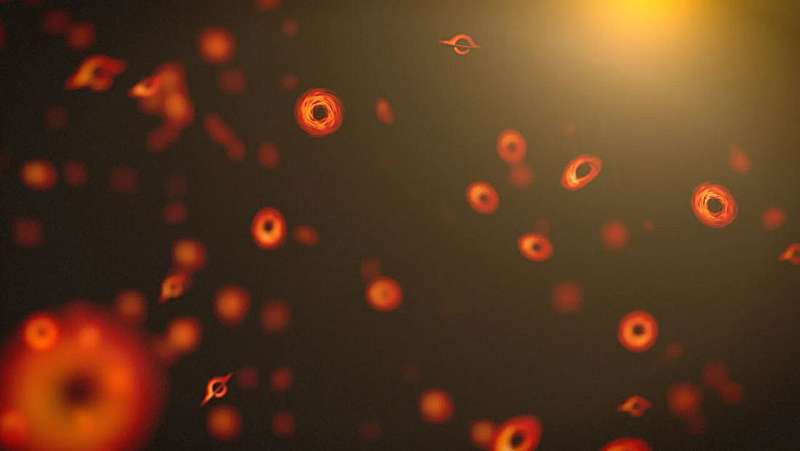This article has been reviewed according to Science X's editorial process and policies. Editors have highlighted the following attributes while ensuring the content's credibility:
fact-checked
preprint
trusted source
proofread
Primordial black holes could kick out stars and replace them

Primordial black holes formed during the earliest stages of the evolution of the universe. Their immense gravity may be playing havoc in stellar systems. They can transfer energy into wide binary systems, disrupting their orbits.
Like celestial bullies, their disruption might lead to extreme outcomes, like ejecting a star and replacing it. A new paper studies the interactions of systems like these and looks at ways we might be able to detect them.
It's been theorized that black holes may have formed during the earliest moments after the Big Bang. They are not the result of supermassive stars having collapsed, but instead forming out of fluctuations in the density of matter.
Regions with great density would simply collapse under their own gravitational influence, forming what have been dubbed primordial black holes (PBHs). They are thought to vary in size from subatomic to more massive than the sun.
Whether primordial black holes really do account for dark matter in the universe is still up for debate. Among the astronomical community, it is generally accepted that they cannot account for all dark matter, but probably account for up to 10% of dark matter in the planetary mass range (10-7 to 10-3 solar masses.) Whether PBHs account for any of the dark matter in the universe requires further analysis.
If large scale is taken into account, then PBHs are indistinguishable from a background of particle dark matter. At small scales, the distribution of PBHs is not uniform across the universe relative to the background of particle dark matter and so we are forced to look for a unique new theory. Observing PBHs to understand how close the model is to reality is difficult, but it is possible to study their interactions with star systems.
A paper by Badal Bhalla from the University of Oklahoma and a team of astronomers, posted to the arXiv preprint server, explores the way PBHs can lose energy when interacting with stellar binary systems. These interactions can result in any one of five possible outcomes:
- Hardening—the two bound objects lose energy to the third free object causing their separation to decrease;
- Softening—the free body transfers energy to the bound system causing their separation to increase but remain bound;
- Disruption—the free body transfers enough energy to the bound system that the components become unbound and all objects continue unbound;
- Capture—the bound objects capture the free object;
- Exchange—the free object transfers enough energy to unbind one of the bound objects and in doing so loses sufficient energy to become bound to the remaining one.
Previous studies have explored softening and disruption in PBH and binary interactions, as has the capture model. The team proposes that hardening is also unlikely and so explores the possibility of the exchange model.
They find that the exchange model should lead to a population of PBH binaries in the Milky Way, and indeed, some observations hint that they may exist. The team also suggests it may be possible to detect PBHs in binary systems with a subsolar mass PBH by the properties of the system.
Observations are now needed to validate the model. The discovery of black holes in a binary system may be possible and would go some way to support the findings.
More information: Badal Bhalla et al, Dancing with invisible partners: Three-body exchanges with primordial black holes, arXiv (2024). DOI: 10.48550/arxiv.2408.04697
Journal information: arXiv
Provided by Universe Today




















